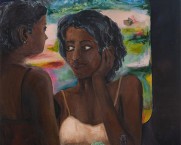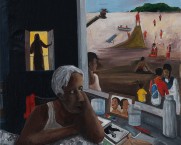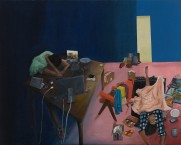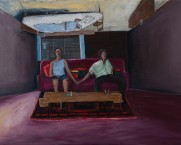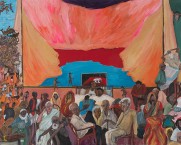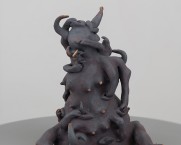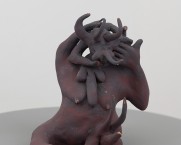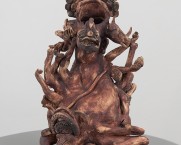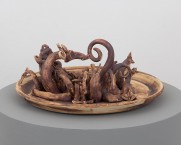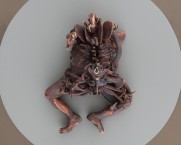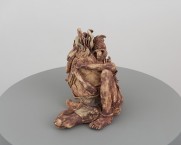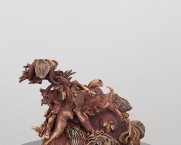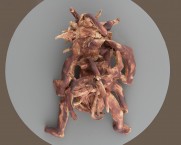C&L Shows
Every Day is an Admission of Guilt
Nityan Unnikrishnan
2023
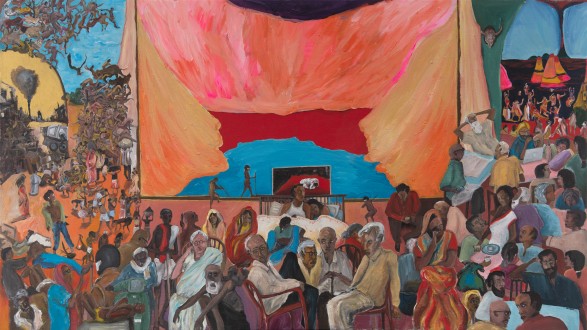
Overview
In the painting, Chorus, a mass of brown human and animal bodies billows skywards in the upper left corner, while visuals from village life horseshoe around the bottom and to the other side. At the bottom one sees people conversing, seated, squatting, youngish and old, some of whom return our gaze, questioning our presence in the scene. To the right, some eat at tables while in the right top corner, one recognizes silo-esque structures that are reminiscent of Nityan Unnikrishnan’s earlier work. Surprisingly, as if a commentary on art itself, the stage, centred in the painting, feels secondary to the drama unfolding around the sides. In another painting, The Phone Call, a couple sits with distant solemnity on a designer sofa, with an equally designed coffee table in the foreground. The colours of the walls, the rug, the sofa, and the floor itself seem to quote Rothko’s palette. But what startles us is the ceiling: an elderly person, bathed in whitish colour, lies on a bed—upside down and defying gravity.
In Nityan Unnikrishnan’s Every Day is an Admission of Guilt, both the painted and sculpted works raise questions about space, formalism, and content; there is a residual tension between the way Unnikrishnan represents controlled indoor spaces and the unconfined outdoors. Indoors, the colours are more homogeneous, the shapes more regular, and the lines well-defined. Indoor spaces seem intentional and organized; like the painting’s frame itself, contained and containing. Not so outside, where the brushwork is freer, lines are hardly ever straight, and a diverse palette often bursts formality and realism. From these latter amorphous and fluctuating spaces emerge the artist’s sculptures too, titled Avarna Sutra (Edicts of the Casteless*), which are neither limited by shape, nor by perspective. Every Day is an Admission of Guilt is Nityan Unnikrishnan’s seventh exhibition at Chatterjee & Lal, and, for many of us, sculpture is new territory. This exhibition feels familiar, therefore, but it also excites us with new media and a different sensibility.
Unnikrishnan’s indoor spaces seem formally concrete, coherent, and immediately apprehensible. While Mortals Sleep, depicting day-labourers who all share a single rented room, is least similar to the others. And yet it contains elements that are comparable to Noise Cancelling, The Distant Landscape, or The Phone Call. Clearly articulated figures, engaged in clearly distinguishable activities—whether scrolling on a phone, cooking, or simply sitting contemplatively before images and documents spread across a desk. Whether a domestic scene, a café romance, or something else, few persons sitting indoors interact with others. They are self-contained. Sometimes, these paintings seem enigmatic: Out of the Corner of the Eye portrays a young girl in an entryway as an adult sits at a desk, sorting aadhar cards and stamp paper. A woman prays just next to the girl. The girl’s impossibly tiny proportions suggest a perspectival view from the corner of the seated man’s eye. It would be difficult to mistake the cause for the man’s slightly forlorn expression: clearly something to do with the girl and the documentation neatly arranged atop his desk. Time and again, Unnikrishnan draws us into a world that almost feels quietist, as if the surface conceals an enigmatic world beyond our access, but it’s up to us to connect the dots. In comparison with the undisguised politics of Unnikrishnan’s earlier work, he tells me, the characters depicted in works exhibited here pause to ruminate, much as he himself has these several years past. Because that thoughtful inner life is often invisible on a painting’s surface, on a person’s face, clues scattered throughout kindle our imaginations, inviting us to interpret.
Sculpture, a genre whose very technique demands the play of space, is Unnikrishnan’s answer to the self-contained and sedentary characters in his paintings. It is as if he knew we’d want to see the outside scenes from his paintings so tangibly sculpted in three dimensions. We’ve observed such forms stretched across a canvas, and now they’ve popped out and stand before our eyes. Shapes shrouded by their own mass reveal themselves as we circumnavigate the sculptures. We see semblances of an animal’s face, a limb, a nipple or pimple, a tusk or horn, all at once. If the Every Day is an Admission of Guilt, then the unruly chaos and mixture of these works prompts us to engage with the oppressive asymmetry of our contemporary world.
Sculpture 4, immediately and viscerally captured my eye. A multifarious form plopped into a large plate, it alludes to ritual offerings, prasad. Across India, and especially on dining tables, young kids learn to mix and dip and combine and recombine foods, all using ubiquitous steel plates with built-in katories for daal, koshimbir (or raita), and bhaji, with a much larger bottom half for some kind of chapati, poli, roti, and rice. Such trays are characteristic of messes and canteens, along with their cheap stamped-steel spoons and forks. Nostalgia mixed with practicality. (I feel obliged to say that my favourite Udupi restaurant still serves on banana leaves—as do the many small roadside restaurants that serve local fare in the artist’s native Kerala. On banana leaves, juices race in parallel lines, to the centre and to the sides. Naturally, we have to mix to prevent a spill.) In this regard, the works of Avarna Sutra, refer, surely, to a kind of caste politics, as the name Avarna Sutra unfailingly reminds us. The caste, class, gendered, and regional overtones that regulate how we approach our meals are vivid reminders of the politics of our foodways and, more generally, our habitus. We carry on these divisive traditions, often unwittingly.
Perhaps, however, that isn’t the only way to square with Unnikrishnan’s latest work. Perhaps, in addition to the overt reference to caste, some more context is in order that accommodates these new directions. Perhaps also, a breakdown in categorical thinking, a larger framework of which caste is one aspect. Categorical thinking’s practices have been everywhere and at all times. But nowhere more so than savarna thought and practice. Caste and purity have a long history of binary affiliations, between what is permissible and what is taboo. How some things are pure and others ritually polluting. Even though Avarna Sutra, simply by that first word, avarna, invokes caste, I suspect these works simultaneously ask us to examine the categories inherent to our everyday, not limited to self, other, human, animal (or monster), food, poison, object, and subject.
And here’s where the title of the entire exhibit provides the key. Every Day is an Admission of Guilt convinces us that the only way to break down our categorical thinking is to acknowledge our complicity with uneven and unjust ways of living in the world. The stark divisions of indoor/outdoor in the paintings of this exhibit are undone by Unnikrishnan’s title: those inside rely and live lives contingent upon the processes outside. The small slum adjacent a middle class vasti is not separate from it, providing all kinds of services—especially domestic labour. The chai katta, the staff at our favourite restaurants; even at the most distant, our retirement funds and portfolios too, invest in companies whose practices of labour probably don’t guarantee a real living wage. “I am a swallower of lives” writes Saleem Sinai, the narrator of Rushdie’s Midnight’s Children: these works precipitate our own introspection: how many lives do we have to know to know ourselves? In sum, we perpetuate inequality simply by living, and Unnikrishnan asks us to become aware of it.
I speak in the abstract, flitting between personal and impersonal, first and third person, singular and plural, precisely because such designations lose salience as we shift our own perspective from Unnikrishnan’s paintings to the sculpture series. There is no separation between the person and the inhabitable world that s/he inhabits. Admitting guilt is an admission of contingency, dependency, and complicity. But it is also cause for a qualified optimism: perhaps a new kind of politics, or politics restructured knowing what we know, but cannot, immediately, escape or change.
*For many who speak Indian languages, the words sutra and varna are complex. Sutra can refer to a thread, a principle, an aphorism, rules, a teaching, or even, sometimes, scripture. Varna too, most often invoked to speak of caste, also, literally, means “colour.” Translated literally, therefore, it could be Colourless Threads. It may be because of the literal definition that varna came to be used to describe caste: a distinction made, some millennia previously, on the basis of skin colour. Being avarna, therefore means being without caste, and also, more interpretively, not of a good colour or without color. Savarna means with caste, referring the three dominant castes in orthodox Hinduism, and, more literally, with a (good) colour. Dwelling on these definitions is significant—we are viewing art here, and colours and pigments are an essential element! In translating Unnikrishnan’s title idiomatically, I have tried to retain what I believe is true to the work itself.
~ Kedar A. Kulkarni
A Video Walkthrough by Mort Chatterjee

